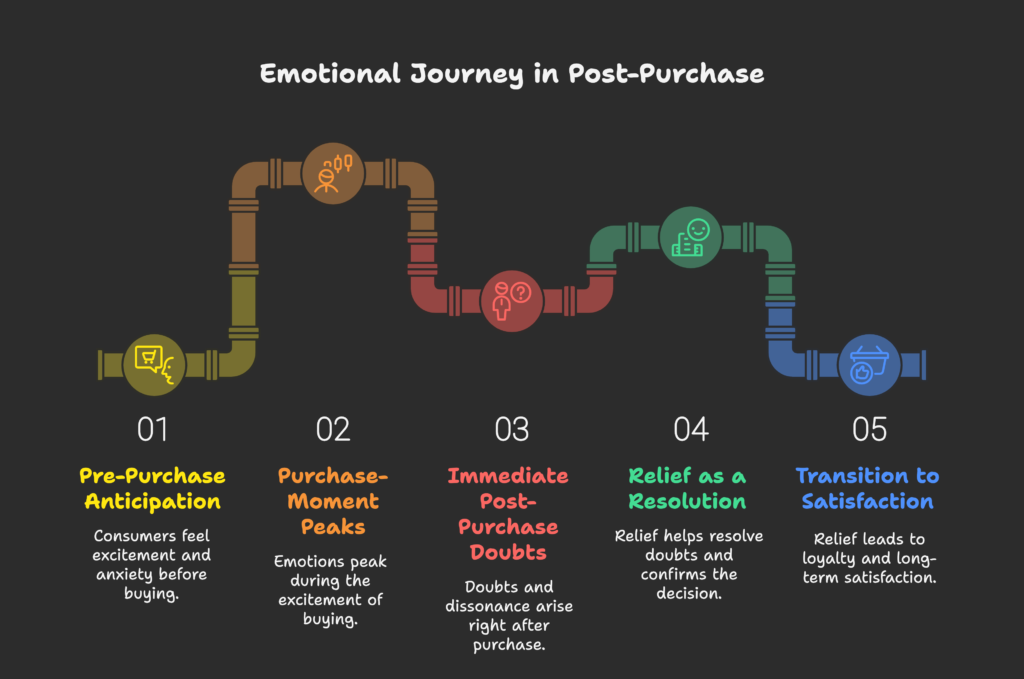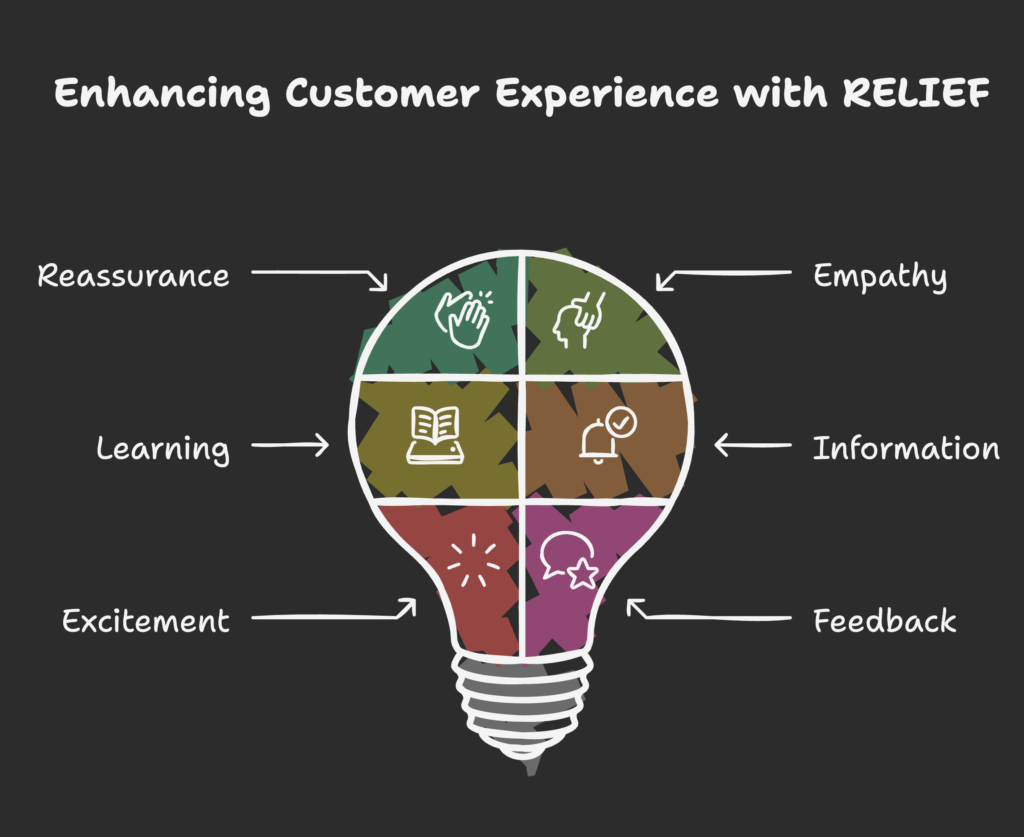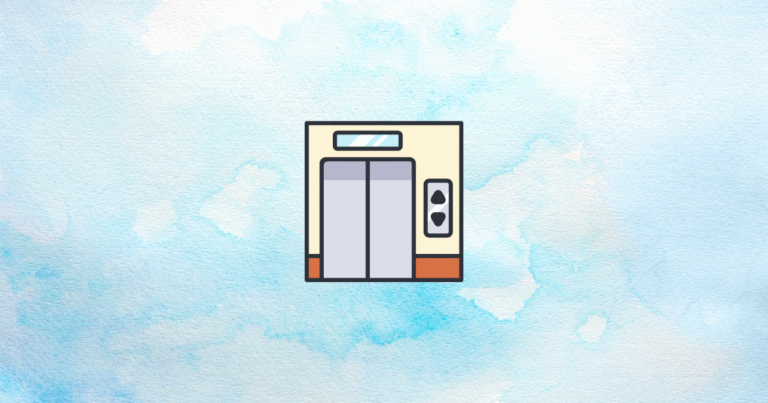Have you ever purchased something and then felt a wave of relief, or maybe a moment of doubt? Would you like to know why those feelings appear and how brands can use them to create better experiences? By the time you finish reading this article, you’ll understand the power of relief in the post-purchase stage and see how it boosts customer loyalty. Ready to discover a whole new perspective on customer emotions? Let’s dive in!
Understanding the Post-Purchase Emotional Landscape
Welcome to a phase often overlooked: the post-purchase stage. This period is critical because it shapes how customers feel about their purchase. According to various studies, many buyers develop strong emotional reactions once the transaction is complete. These reactions, ranging from excitement to doubt, can influence whether they remain loyal or move on to another brand.
- Definition and range of post-purchase emotions: Feelings can vary from joy and satisfaction to regret and frustration.
- The critical importance of the post-purchase phase: Positive emotions here can encourage repeat business and stronger loyalty.
- Statistical evidence of impact on brand loyalty: Research shows that a satisfied customer is more likely to recommend a brand to friends and family.
- The underexplored potential of relief: While many brands focus on excitement, relief can be just as powerful for cementing trust.
Now that you have a sense of why the post-purchase phase matters, let’s look deeper into the star of the show: relief.
The Relief Emotion: Psychological Foundation
Relief is that liberating sensation you experience once you confirm the right choice was made. In consumer psychology:
- Definition of relief: A sense of release from worries tied to making the wrong choice or wasting money.
- Relief as the counterbalance to purchase anxiety: It neutralizes feelings like doubt or tension.
- Neurological mechanisms: When relief is triggered, the brain rewards you with a dopamine release, reinforcing the decision.
- Relationship to other positive emotions: Relief often comes alongside satisfaction and happiness, enhancing the customer’s overall mood.
With that foundational understanding, we can see why relief is not just a fleeting feeling but a strategic asset. Let’s explore its value for businesses next!
The Business Value of Orchestrating Post-Purchase Relief
Designing experiences that encourage relief can dramatically boost customer satisfaction. Here’s why:
- Impact on satisfaction and loyalty metrics: Feeling calm and confident after a purchase increases the chances of repeat business.
- Lower return rates and support costs: When customers are assured they made the right choice, they are less likely to return items or call support.
- Word-of-mouth amplification: People love to share feel-good experiences, fueling referrals and positive reviews.
- Competitive differentiation: Providing emotional reassurance sets you apart from competitors who only focus on marketing before the sale.
Great! We’ve seen why relief matters and how it benefits both customers and brands. Let’s move on to the psychological background that fuels these emotions.
The Psychology of Post-Purchase Emotional States
Get ready to uncover the mental processes behind post-purchase emotions. In this part, we’ll talk about why cognitive dissonance occurs, how buyer’s remorse develops, and how relief can save the day.

Cognitive Dissonance and Buyer’s Remorse
After buying something, consumers sometimes feel uneasy about their decision. This unease is called cognitive dissonance:
- Theory in purchasing: When reality (the purchased item) conflicts with expectations, doubt creeps in.
- How post-purchase dissonance shows up: Customers might obsess over negative reviews or wonder if there was a cheaper option.
- Common triggers of buyer’s remorse: High prices, complicated return policies, or peer pressure.
- Psychological cost of unaddressed anxiety: If these worries remain unresolved, it can damage the brand-customer relationship.
Now that we see how dissonance forms, let’s check out the role that relief plays in overcoming these feelings.
Relief as a Dissonance Resolution Mechanism
Relief is the feeling that neutralizes that inner tension. It helps customers think, “Yes, I made the right call!”
- How relief counteracts dissonance: It wipes away lingering doubts by confirming a good decision.
- The temporal dynamics: Relief is most powerful shortly after purchase, but it can lead to long-term satisfaction if managed well.
- Individual differences: Some people feel relief faster than others, depending on personal factors like spending habits or risk tolerance.
- Bridge to satisfaction: Once relief is felt, it often transitions into loyalty and trust.
We’ve addressed how relief counters doubt. Next, let’s explore the entire emotional sequence and see why timing is everything.
Emotional Sequence in the Purchase Journey
Buying a product or service involves a mini emotional rollercoaster:
- Pre-purchase anticipation and anxiety: Questions like “Will it work?” or “Is it worth the cost?”
- Purchase-moment peaks: Excitement or second thoughts right as the payment goes through.
- Immediate post-purchase vulnerability: This is where doubts and relief both have a chance to appear.
- The critical relief window: The moment right after purchase when a brand can ease worries.
- Transition to long-term satisfaction: If relief is guided properly, it becomes loyalty and delight over time.
Knowing these steps helps you decide when to step in and offer reassurance. In the next section, we’ll map out where and how to deliver that relief.
Mapping the Post-Purchase Relief Opportunities
Next, we’ll explore the key moments for introducing relief, how to build a journey map, and considerations for different product types. This will help you plan an effective approach to create a calming experience for your customers.
Identifying Key Moments for Relief Intervention
There are several touchpoints where relief can be most effective:
- Transaction confirmation: Sending an immediate email to confirm the purchase and thank the customer.
- Shipping and delivery updates: Frequent, transparent updates ease anxiety about package arrival.
- Unboxing and first use: Clear, simple instructions and a pleasant unboxing experience reduce confusion.
- Post-usage validation: Asking for feedback or providing success stories assures customers they are not alone.
- Service and support interactions: Proactive help channels can transform frustration into relief.
Ready to see how all these touchpoints work together? Let’s continue and build a more visual plan for the entire post-purchase journey.
Customer Journey Relief Mapping
A post-purchase emotional journey map outlines each step the customer takes after buying:
- Identifying emotional pain points: Spot where doubts spike, then insert reassurance methods.
- Channel-specific relief: For example, quick SMS alerts might be best for delivery updates, while a call could be ideal for complex issues.
- Balancing automation with human touch: Automated notifications can keep people informed, but a personal approach fosters deeper trust.
We’ve learned how to chart relief across a general journey. Now, let’s examine how relief might change depending on the type of product or service.
Product Category-Specific Relief Considerations
Different products require different levels of reassurance:
- High-consideration purchases: Electronics, furniture, or big-ticket items often demand more detailed reassurance, such as longer warranties.
- Routine purchases: Even buying groceries online can benefit from confirmation messaging to reduce small anxieties.
- Luxury vs. necessity: Luxury items might need extra personal touches and brand storytelling, while necessities emphasize utility and reliability.
- Service-based purchases: From consulting to subscriptions, clear onboarding and transparent follow-up are crucial.
Now that we know how to map and adapt relief across categories, let’s move into creating a structured framework for ensuring you deliver relief every step of the way.
Strategic Framework for Relief-Centered Post-Purchase Experience
Here, you’ll learn a practical model called RELIEF and discover how to time your communication for maximum emotional impact. You’ll also see how to coordinate various channels to build a seamless experience.
The RELIEF Model for Post-Purchase Strategy

Think of RELIEF as six guiding actions:
- Reassurance: Reinforce the customer’s choice with a friendly confirmation and clear next steps.
- Empathy: Show understanding for the emotional and financial investment they’ve made.
- Learning: Help them use the product or service effectively through tutorials or tips.
- Information: Keep them updated on shipping, delivery, and account details.
- Excitement: Build anticipation for receiving or using the product, keeping the positive momentum.
- Feedback: Invite them to share their experience or ask questions, closing any loops of doubt.
With these steps in mind, let’s look at the ideal timeline to apply each one.
Timing Considerations for Maximum Relief Impact
Timing can turn a neutral experience into a delightful one:
- Immediate post-purchase: A confirmation email or text can instantly assure the buyer.
- Pre-delivery anxiety management: Regular updates reduce worries about shipping delays.
- First-use strategies: Quick guides or how-to videos presented right when the product arrives.
- Long-term reinforcement: Periodic check-ins to ensure continued satisfaction and remind them of product benefits.
Next, we’ll see how to orchestrate these ideas across the many channels your customers use.
Channel and Touchpoint Orchestration
A relief-centered approach should work smoothly across emails, phone calls, social media, and more:
- Email sequences: Structured follow-ups that thank, inform, and encourage feedback.
- Mobile notifications: Short, timely reminders about delivery status or new product tips.
- Packaging and unboxing design: Include warm greetings, easy instructions, and maybe a small extra treat.
- Social media reinforcement: Share success stories or invite customers to do the same.
- Customer service scripts: Train your team to proactively offer reassurance, not just solve problems.
Great work so far! Now, let’s move from the broad strategy to specific tactics you can use right away.
Tactical Implementation of Relief Strategies
Get ready for concrete ideas you can apply to your business today, from confirming orders in a friendly way to providing educational content for confidence.
Confirmation and Reassurance Tactics
Securing confidence starts with the moment the payment is confirmed:
- Order confirmation design: Keep it simple, warm, and clear. Highlight what was purchased and what to expect next.
- Social validation: Add phrases like “Others who bought this product rated it highly!”
- Expert validation signals: For instance, mention if it’s “award-winning” or “expert-approved.”
- Value reinforcement: Remind them of benefits, such as “long battery life” or “premium quality.”
Reinforcing the purchase is one piece. Next, let’s tackle how to calm anxieties that appear after the sale.
Anxiety Reduction Through Information
Keeping customers informed cuts down on post-purchase worries:
- Shipping and tracking optimization: Offer clear timelines and tracking links via email or text.
- Proactive delay management: If you foresee any delay, let them know in advance to manage expectations.
- Transparent communication: If a product is on backorder, be honest and keep them updated.
- Setting realistic expectations: Avoid overpromising about delivery or product capabilities.
Next, we’ll discuss how to increase confidence through educational content, so customers feel fully prepared.
Educational Content for Usage Confidence
When customers receive guidance and knowledge, relief and satisfaction naturally follow:
- Welcome and onboarding sequences: Introduce the main features or benefits step by step.
- Getting started guides: Short videos or easy-checklist PDFs that walk them through setup or first use.
- Preemptive troubleshooting resources: Provide FAQs or tutorials to solve common issues before they become problems.
- Community and peer learning: Encourage customers to connect in forums or groups to share tips and experiences.
Once they’re comfortable using the product, it’s time to validate their choice even further. Let’s see how!
Post-Usage Validation Techniques
Confirming success is a wonderful way to maintain long-term enthusiasm:
- Timing of satisfaction check-ins: Send a friendly email a few days or weeks after delivery asking, “How’s it going?”
- Smart timing for feedback requests: Ask for reviews once the customer has had a chance to genuinely experience the product.
- Success story sharing: Show real-life examples of people achieving great results.
- Achievement recognition: Celebrate milestones, whether it’s the 10th use or a certain accomplishment with the product.
Now that you have the tactics, let’s explore advanced methods to boost relief and build even stronger relationships.
Advanced Relief-Building Strategies
In this section, we’ll look at personalization, community-building, and how to surprise customers in ways that deepen their trust and excitement.
Personalization of Relief Experiences
One-size-fits-all is never as impactful as personalized attention:
- Customer data usage: Use purchase history to provide tailored recommendations or compliments.
- Previous purchase behavior: If they bought running shoes, suggest tips on boosting their fitness routine.
- Emotional profile development: Track what matters most to them—cost, quality, or sustainability—and send relevant reassurances.
- Adaptive messaging: If a customer shows signs of anxiety (e.g., many support tickets), follow up with extra reassurance messages.
We’ve addressed personalization. But another powerful tool is community. Let’s see how it helps create group-wide relief.
Community-Based Relief Facilitation
Bringing customers together can strengthen their sense of satisfaction:
- Peer support communities: Online forums or social media groups let customers share tips and reduce post-purchase fears.
- User story highlights: Show how others overcame challenges or maximized product benefits.
- Shared emotional validation: Customers realize they’re not alone in their worries or enthusiasm.
Up next, we’ll talk about delightful surprises that make people feel extra special and turn relief into genuine excitement.
Surprise and Delight for Relief Amplification
Everyone loves a pleasant surprise:
- Unexpected bonuses or gifts: A free accessory or discount code to spark joy.
- Extra service touches: Personalized thank-you notes or packaging details can leave a lasting impression.
- Milestone acknowledgment: If a product helps them reach a goal, celebrate it with them.
Finally, to keep that relief thriving over the long run, loyalty programs can be key.
Loyalty Programs as Relief Reinforcement
Rewarding customers for sticking around strengthens trust and reassurance:
- Points as tangible validation: Every purchase earns points, proving the value of their decision.
- Status levels: Let them see how their commitment unlocks greater privileges.
- Exclusive content access: Feeling “in the know” reduces the fear of missing out.
- Early access or insider info: Helps them feel special and confident about staying loyal.
We’ve gone over some advanced ideas. Now, let’s figure out how to measure whether all these strategies are actually working.
Measuring the Impact of Relief Strategies
Here, we explore the key metrics for evaluating relief-focused methods, plus practical ways to gather feedback and optimize interventions through testing.
Key Performance Indicators for Relief Effectiveness
Tracking these metrics helps you see how relief impacts your bottom line:
- Return rate analysis: Fewer returns often mean better post-purchase satisfaction.
- Reduction in service contacts: If customers feel secure, they won’t flood your help desk.
- Repeat purchase behavior: Loyal customers are evidence of successful relief strategies.
- Referral and advocacy: Happy, relieved customers naturally recommend you.
- Review sentiment analysis: Look for positive keywords in reviews like “relief,” “reassured,” or “no worries.”
All these numbers tell a story, but they get even richer when combined with direct customer feedback. Let’s see how to gather it.
Customer Feedback and Research Methods
Learn about your customers’ feelings straight from the source:
- Emotion tracking surveys: Ask specifically about how they felt post-purchase.
- Relief-focused feedback: Include questions like, “Did you feel any sense of relief after your purchase?”
- Longitudinal journey mapping: Gather feedback at multiple points to see how feelings evolve over time.
- Qualitative research: Conduct phone interviews or focus groups to dive deeper into emotional nuances.
With that intel in hand, you can test different interventions and constantly refine them. Next up, we’ll cover A/B testing.
A/B Testing Relief Interventions
Split-testing allows you to see which strategy leads to the greatest sense of relief:
- Designing interventions: For example, compare two types of confirmation emails—one with social proof vs. one without.
- Segmentation considerations: Test among different audience segments who might respond to relief differently.
- Interpreting results: Look for shifts in metrics like return rates or feedback survey scores.
- Continuous optimization: Keep refining until you find the best approach for your unique customer base.
Now you know how to measure and optimize. Let’s see real-world examples of how relief strategies work in practice.
Case Studies and Success Stories
In this section, we’ll explore examples from e-commerce and service-based businesses, plus scenarios with bigger purchases where relief is highly critical.
E-commerce Relief Implementation Examples
Online stores can reduce uncertainty and boost loyalty through:
- Post-purchase email campaigns: Sending a friendly series of emails guiding new owners through product use.
- Unboxing experience optimization: Clean, visually appealing packaging and welcoming messages.
- Improved return policy communication: A clear policy that offers hassle-free returns reduces post-purchase worry.
- Shipping anxiety management: Real-time tracking details or helpful chatbots for immediate questions.
Now, let’s jump into how service-based companies create relief.
Service Business Relief Strategies
Whether you run a subscription or a professional service, relief is essential:
- Subscription onboarding examples: Show new subscribers how to get the most value, step by step.
- Professional service reassurance: Provide clear timelines, project milestones, and regular updates.
- Digital product activation: Offer quick tutorials and personal support for new features.
- Membership and community building: Foster a sense of belonging and shared learning among clients.
Finally, for those big-ticket transactions, the stakes (and relief needs) are even higher.
High-Stakes Purchase Relief Management
When the investment is large, strong emotional support can make or break the entire experience:
- Luxury brand protocols: Personalized follow-ups, exclusive communities, and VIP-style support.
- Real estate emotional management: Clear steps, legal guidance, and consistent communication to reduce stress.
- Financial services anxiety reduction: Transparent statements, proactive notifications, and helpful advisors.
- Technology implementation support: Dedicated customer success managers to guide new software users.
Seeing how different industries address relief highlights the challenges and ethical questions that come with emotional strategies, so let’s talk about that next.
Challenges and Ethical Considerations
While creating relief is beneficial, it’s important to maintain honesty, respect privacy, and use resources wisely. Let’s see how to balance all these factors.
Balancing Relief with Authenticity
Too much sugar-coating can damage trust. Instead, aim for honest communication:
- Avoid overcompensation: Don’t promise a perfect experience if there’s a chance of issues.
- Manage product shortcomings: Be upfront about limitations and solutions.
- Build trust through honesty: Customers appreciate brands that respect their intelligence.
Being authentic is crucial, but so is respecting customer data. Let’s see how that works.
Privacy and Personalization Tensions
Personalization is great, but it must be done responsibly:
- Ethical data use: Only collect what you truly need to enhance relief.
- Transparency in design: Clearly explain how and why you use their information.
- Customer control: Let them choose how frequently they receive messages or updates.
- Cultural and individual differences: Some customers prefer more frequent communication, others less.
Finally, no strategy can succeed without proper resources and prioritization. Let’s consider those next.
Resource Allocation and Prioritization
You can’t do it all at once, so prioritize wisely:
- Appropriate investment: Weigh the cost of implementing new relief features against their potential payoff.
- Balancing pre- vs. post-purchase focus: Many brands overspend on acquisition and ignore retention.
- Identifying highest-impact touchpoints: Start where customers experience the most anxiety.
- Making the business case: Show stakeholders how relief leads to loyalty and revenue growth.
We’ve covered the main caution points. Now, let’s give you an implementation guide for getting started and peek into the future of post-purchase emotional design.
Implementation Guide and Future Directions
Ready to put these ideas into action? This section offers a quick approach to begin your relief-centered strategy, insights on building a culture around it, and a glimpse of emerging technologies.
Getting Started with Relief-Centered Strategy
Before you jump in, take these initial steps:
- Assess current post-purchase emotions: Gather customer feedback or run surveys to learn how they feel now.
- Identify quick-win opportunities: Perhaps an immediate post-purchase email or a revised returns policy that’s clearer.
- Align resources and teams: Make sure marketing, support, and product teams work together on relief initiatives.
- Pilot program: Start small, measure the impact, then refine.
With the basics in place, the next step is to create an organization that values emotional intelligence at every level.
Building a Relief-Centered Organization
For real impact, relief strategies need to be part of the company culture:
- Cross-functional collaboration: Marketing, customer service, and product teams should share insights on customer emotions.
- Training for relief-sensitive interactions: Educate your team about the importance of empathy and timing.
- Internal recognition for relief creation: Celebrate employees who excel at calming customer concerns.
- Cultural development for emotional intelligence: Encourage an environment where empathetic listening is a norm.
As technology advances, it opens new possibilities for emotional tracking and engagement. Let’s see what the future might bring.
The Future of Post-Purchase Emotional Engineering
Innovation will make post-purchase experiences even more dynamic:
- AI and predictive emotional modeling: Identifying customer moods and offering personalized messages at just the right moment.
- Biometric feedback: Wearables could detect stress or excitement levels to tailor support in real time.
- Immersive and mixed-reality experiences: Offering augmented reality tutorials or virtual unboxing experiences.
- Voice and conversational interfaces: Voice assistants that can sense emotional cues and respond accordingly.
Now, let’s wrap it all up with some final thoughts and an action plan.
Conclusion
If you’ve come this far, you’ve gained a deep understanding of how relief and other post-purchase emotions can shape the customer journey. By actively easing fears and doubts, you create happier customers who buy more and tell others about your brand. Let’s sum up the key points and show you how to get started.
Key Takeaways
- Relief is powerful: It steadies emotions right when customers might waver after purchase.
- Strategic framework: Use the RELIEF model to guide every post-purchase interaction.
- Measurement and optimization: Keep an eye on key metrics like return rates and feedback sentiment.
- Competitive advantage: Emotional intelligence is a strong differentiator in a crowded market.
Action Plan for Implementation
- Assess and set a baseline: Understand current customer emotions and identify quick improvements.
- Prioritize interventions: Choose the highest-impact areas first, whether that’s shipping updates or onboarding guides.
- Test and optimize: Use A/B testing to find the best approaches for different audience segments.
- Plan for long-term integration: Integrate relief strategies into company culture and keep innovating.
By weaving relief into your post-purchase approach, you’ll see happier customers, stronger loyalty, and greater word-of-mouth.
One last note for Shopify store owners: If you’d like to take your sales even further, consider using Growth Suite—an app that helps increase conversions and enhance the entire customer experience.
References
- EKE. (2023). Consumers’ Post-Purchase Dissonance Reinforcement Strategies. IMSUJCS, 8(1), 78–89.
- Study.com. (n.d.). Post-Purchase Dissonance | Definition, Behavior & Examples.
- Kivimaa, H. (2025). Optimizing post-purchase operations for a great shopping experience. Katana MRP.
- Indeed.com. (2024, August 16). Emotional Marketing: A Guide (Plus 8 Key Strategies).
- Kwok, A. (2023, October 6). Buyer’s remorse laws: Buyers don’t just have remorse, they also have rights. MNP Debt.
- Ryviu. (2023, December 20). Post Purchase Dissonance: 8 Clever Ways to Reduce It.
- Laderchi, E., & Battistini, F. (2021). Impulse Buying Behaviour and Post-Purchase Regret…
- Wonderment. (2021, June 25). Post Purchase Marketing 101.
- Cuong, D.T. (2024). Positive emotions influencing consumer shopping behavior on E-commerce platforms. Management and Marketing, 19(1), 15–31.
- Scarlet Media. (2024, September 4). How MENA Consumers Decide What to Buy: Emotional Purchase Decisions.
- WareIQ. (2025, January 3). 7 Ways to Reduce Post Purchase Dissonance for Sellers (2025).
- Rokt. (2024, December 18). What Is the Phase 3 Post-Purchase Process? A Blueprint for Success.
- Fomo. (2024, September 10). 20 Emotional Marketing Examples to Take Inspiration From.
- Spergel. (2023, April 7). Buyer’s remorse laws: how they can save you from debt.
- Bukevica & Dubina. (2022, November 6). A Study on Post-Impulsive Buying Emotions…
- Retail Customer Experience. (2025, January 7). Why emotions matter in retail customer journeys.
- ReverseLogix. (2024, November 19). Post-Purchase Behavior: Definition, Outcomes, & Steps.
- LinkedIn. (2023, October 28). Discover the emotions of your customers buying journey.




